The Role and Importance of IT in the Service Sector: Bank of Scotland
VerifiedAdded on 2021/02/20
|11
|4302
|114
Report
AI Summary
This report analyzes the role and importance of Information Technology (IT) within companies, specifically focusing on the service sector, using the Bank of Scotland as a case study. It explores IT's impact on organizational success, covering areas such as innovation, decision-making, marketing, customer support, and resource management. The report delves into ethical and social issues in banking, including social and ethical banking practices, IT-based services, and data privacy. It differentiates between various networking technologies like PAN, WAN, SAN, MAN, and SAN, highlighting their application within the bank. Furthermore, the report discusses the significance of intranets and the internet in business operations. Finally, it touches upon the different stages of the system development life cycle. The analysis is supported by a literature review, and the report concludes with recommendations based on the discussions.

Individual Report
Paraphrase This Document
Need a fresh take? Get an instant paraphrase of this document with our AI Paraphraser
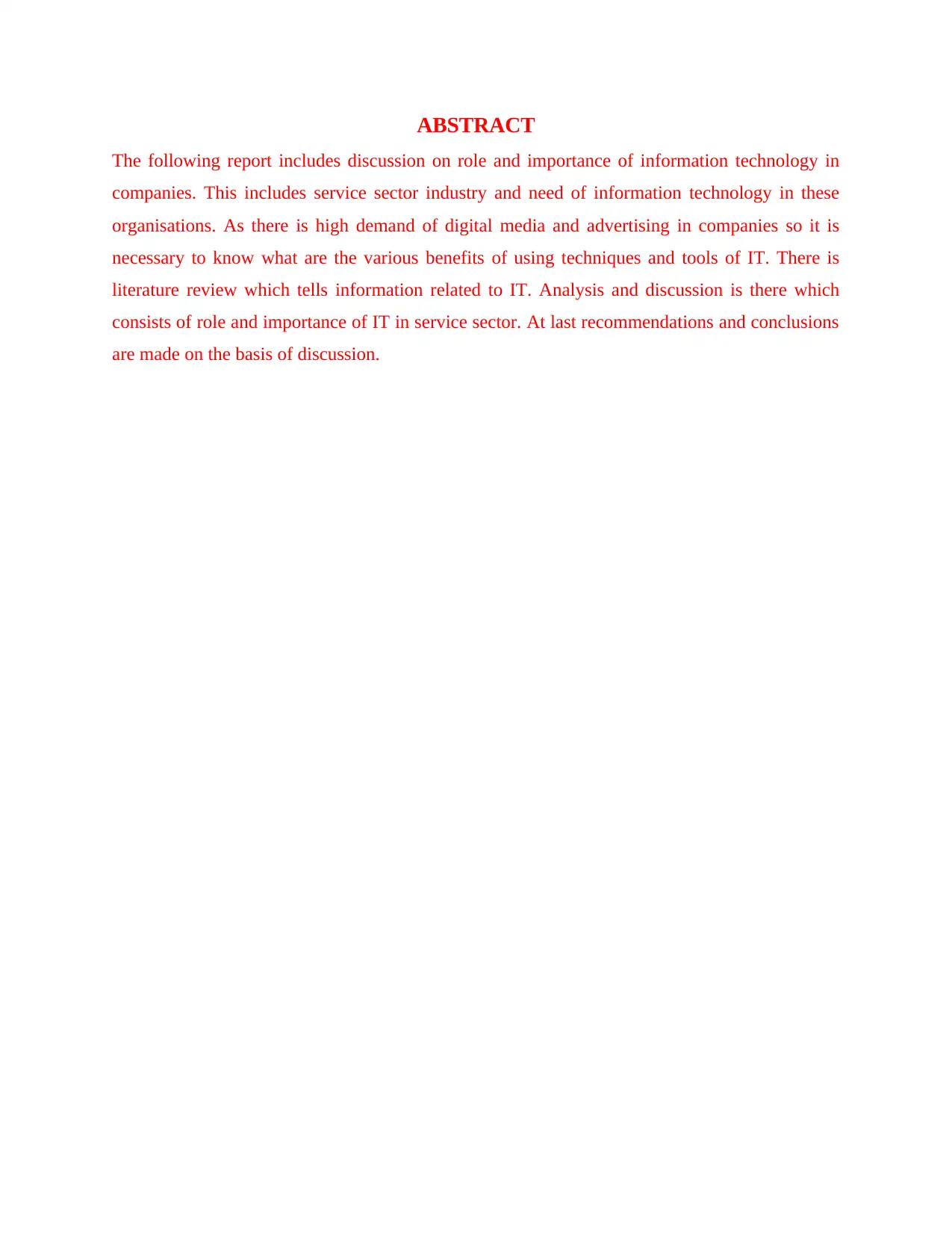
ABSTRACT
The following report includes discussion on role and importance of information technology in
companies. This includes service sector industry and need of information technology in these
organisations. As there is high demand of digital media and advertising in companies so it is
necessary to know what are the various benefits of using techniques and tools of IT. There is
literature review which tells information related to IT. Analysis and discussion is there which
consists of role and importance of IT in service sector. At last recommendations and conclusions
are made on the basis of discussion.
The following report includes discussion on role and importance of information technology in
companies. This includes service sector industry and need of information technology in these
organisations. As there is high demand of digital media and advertising in companies so it is
necessary to know what are the various benefits of using techniques and tools of IT. There is
literature review which tells information related to IT. Analysis and discussion is there which
consists of role and importance of IT in service sector. At last recommendations and conclusions
are made on the basis of discussion.
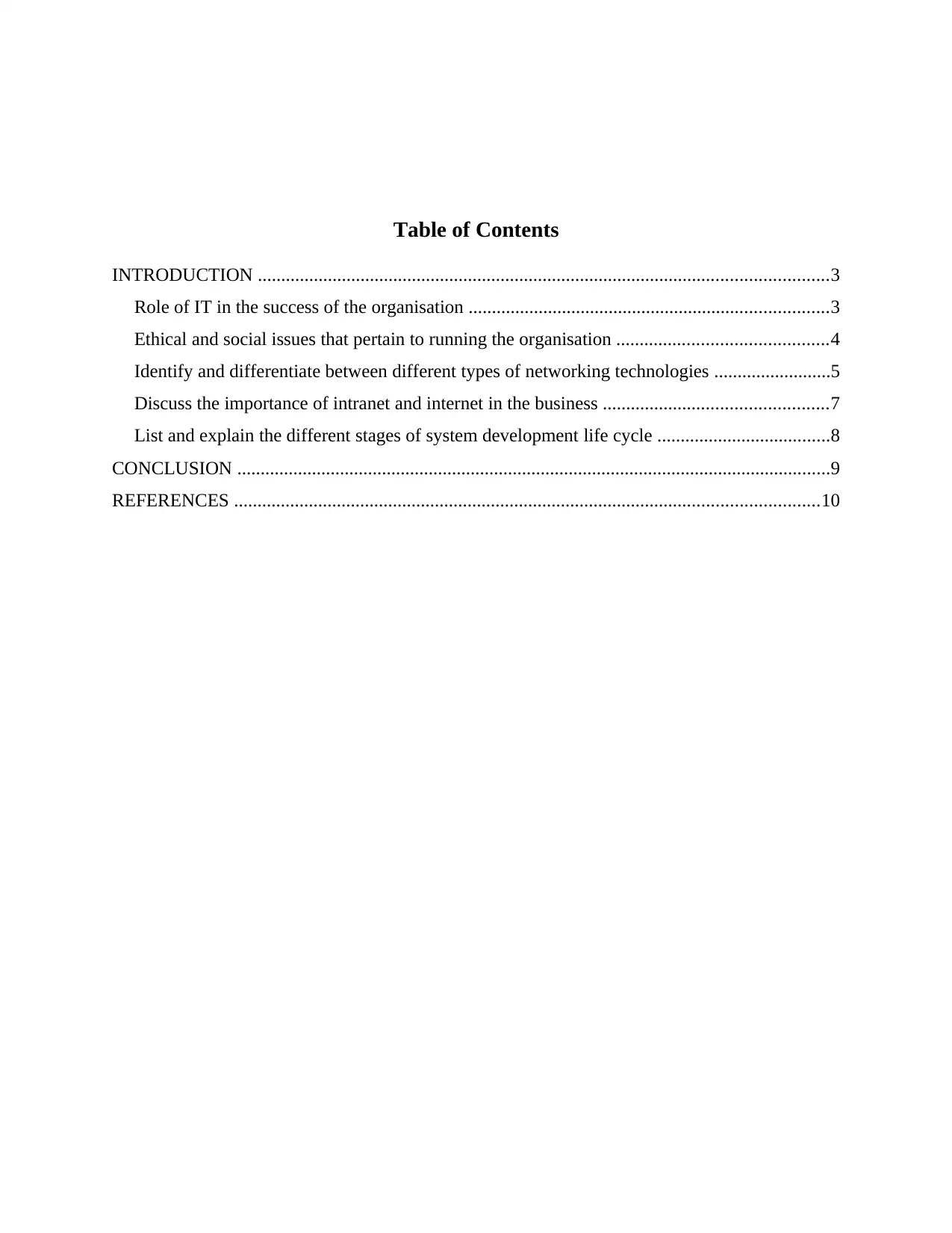
Table of Contents
INTRODUCTION ..........................................................................................................................3
Role of IT in the success of the organisation .............................................................................3
Ethical and social issues that pertain to running the organisation .............................................4
Identify and differentiate between different types of networking technologies .........................5
Discuss the importance of intranet and internet in the business ................................................7
List and explain the different stages of system development life cycle .....................................8
CONCLUSION ...............................................................................................................................9
REFERENCES .............................................................................................................................10
INTRODUCTION ..........................................................................................................................3
Role of IT in the success of the organisation .............................................................................3
Ethical and social issues that pertain to running the organisation .............................................4
Identify and differentiate between different types of networking technologies .........................5
Discuss the importance of intranet and internet in the business ................................................7
List and explain the different stages of system development life cycle .....................................8
CONCLUSION ...............................................................................................................................9
REFERENCES .............................................................................................................................10
⊘ This is a preview!⊘
Do you want full access?
Subscribe today to unlock all pages.

Trusted by 1+ million students worldwide
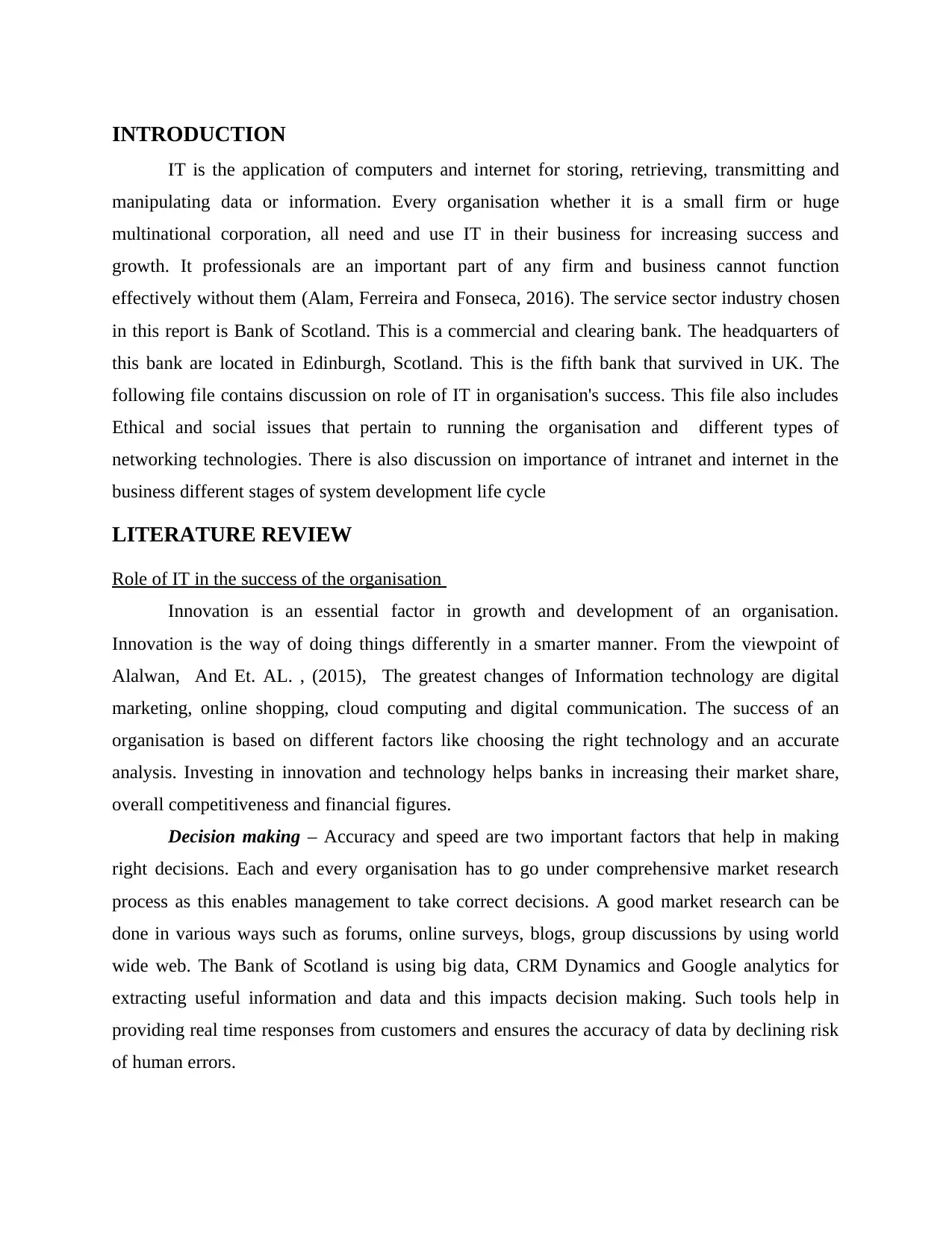
INTRODUCTION
IT is the application of computers and internet for storing, retrieving, transmitting and
manipulating data or information. Every organisation whether it is a small firm or huge
multinational corporation, all need and use IT in their business for increasing success and
growth. It professionals are an important part of any firm and business cannot function
effectively without them (Alam, Ferreira and Fonseca, 2016). The service sector industry chosen
in this report is Bank of Scotland. This is a commercial and clearing bank. The headquarters of
this bank are located in Edinburgh, Scotland. This is the fifth bank that survived in UK. The
following file contains discussion on role of IT in organisation's success. This file also includes
Ethical and social issues that pertain to running the organisation and different types of
networking technologies. There is also discussion on importance of intranet and internet in the
business different stages of system development life cycle
LITERATURE REVIEW
Role of IT in the success of the organisation
Innovation is an essential factor in growth and development of an organisation.
Innovation is the way of doing things differently in a smarter manner. From the viewpoint of
Alalwan, And Et. AL. , (2015), The greatest changes of Information technology are digital
marketing, online shopping, cloud computing and digital communication. The success of an
organisation is based on different factors like choosing the right technology and an accurate
analysis. Investing in innovation and technology helps banks in increasing their market share,
overall competitiveness and financial figures.
Decision making – Accuracy and speed are two important factors that help in making
right decisions. Each and every organisation has to go under comprehensive market research
process as this enables management to take correct decisions. A good market research can be
done in various ways such as forums, online surveys, blogs, group discussions by using world
wide web. The Bank of Scotland is using big data, CRM Dynamics and Google analytics for
extracting useful information and data and this impacts decision making. Such tools help in
providing real time responses from customers and ensures the accuracy of data by declining risk
of human errors.
IT is the application of computers and internet for storing, retrieving, transmitting and
manipulating data or information. Every organisation whether it is a small firm or huge
multinational corporation, all need and use IT in their business for increasing success and
growth. It professionals are an important part of any firm and business cannot function
effectively without them (Alam, Ferreira and Fonseca, 2016). The service sector industry chosen
in this report is Bank of Scotland. This is a commercial and clearing bank. The headquarters of
this bank are located in Edinburgh, Scotland. This is the fifth bank that survived in UK. The
following file contains discussion on role of IT in organisation's success. This file also includes
Ethical and social issues that pertain to running the organisation and different types of
networking technologies. There is also discussion on importance of intranet and internet in the
business different stages of system development life cycle
LITERATURE REVIEW
Role of IT in the success of the organisation
Innovation is an essential factor in growth and development of an organisation.
Innovation is the way of doing things differently in a smarter manner. From the viewpoint of
Alalwan, And Et. AL. , (2015), The greatest changes of Information technology are digital
marketing, online shopping, cloud computing and digital communication. The success of an
organisation is based on different factors like choosing the right technology and an accurate
analysis. Investing in innovation and technology helps banks in increasing their market share,
overall competitiveness and financial figures.
Decision making – Accuracy and speed are two important factors that help in making
right decisions. Each and every organisation has to go under comprehensive market research
process as this enables management to take correct decisions. A good market research can be
done in various ways such as forums, online surveys, blogs, group discussions by using world
wide web. The Bank of Scotland is using big data, CRM Dynamics and Google analytics for
extracting useful information and data and this impacts decision making. Such tools help in
providing real time responses from customers and ensures the accuracy of data by declining risk
of human errors.
Paraphrase This Document
Need a fresh take? Get an instant paraphrase of this document with our AI Paraphraser
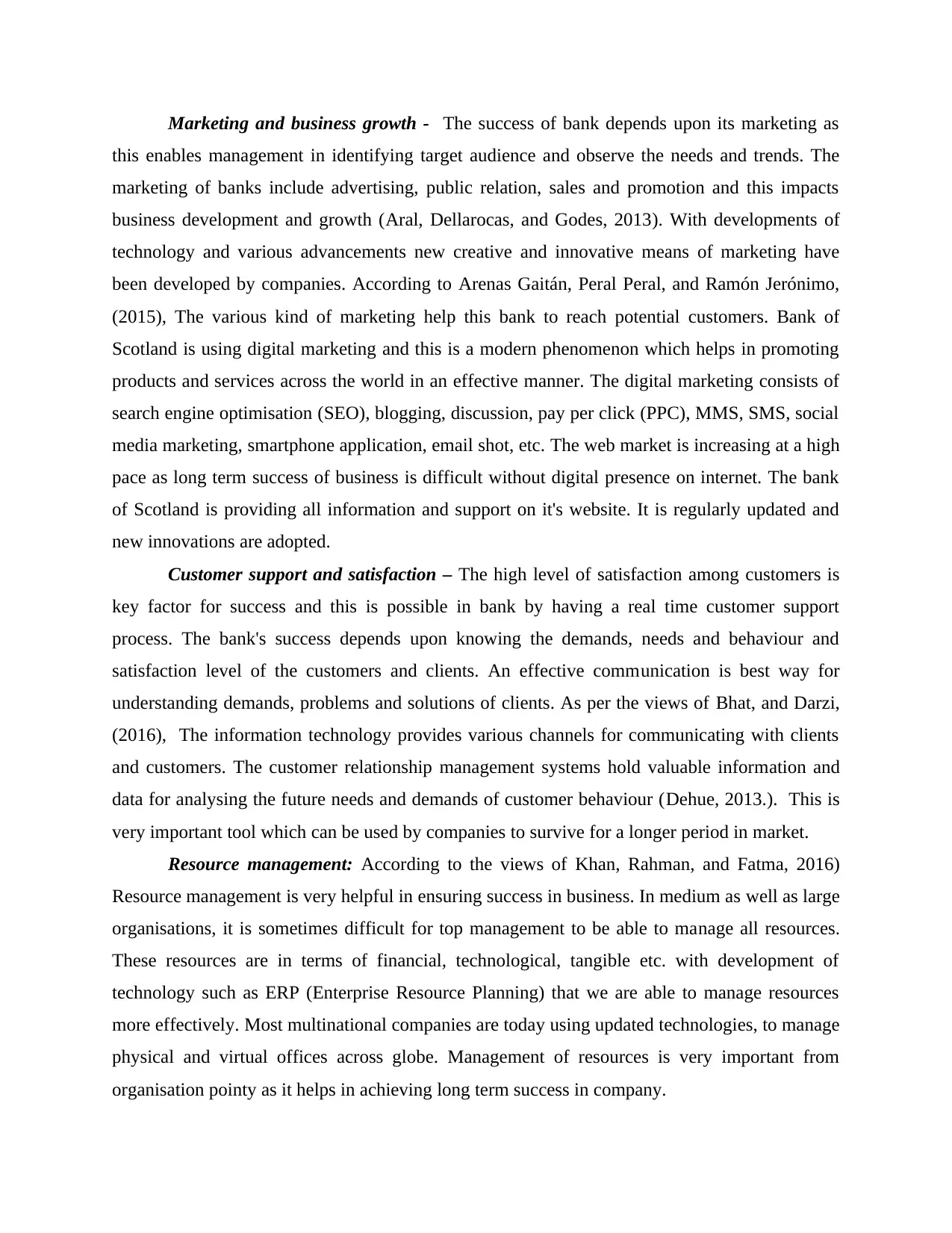
Marketing and business growth - The success of bank depends upon its marketing as
this enables management in identifying target audience and observe the needs and trends. The
marketing of banks include advertising, public relation, sales and promotion and this impacts
business development and growth (Aral, Dellarocas, and Godes, 2013). With developments of
technology and various advancements new creative and innovative means of marketing have
been developed by companies. According to Arenas Gaitán, Peral Peral, and Ramón Jerónimo,
(2015), The various kind of marketing help this bank to reach potential customers. Bank of
Scotland is using digital marketing and this is a modern phenomenon which helps in promoting
products and services across the world in an effective manner. The digital marketing consists of
search engine optimisation (SEO), blogging, discussion, pay per click (PPC), MMS, SMS, social
media marketing, smartphone application, email shot, etc. The web market is increasing at a high
pace as long term success of business is difficult without digital presence on internet. The bank
of Scotland is providing all information and support on it's website. It is regularly updated and
new innovations are adopted.
Customer support and satisfaction – The high level of satisfaction among customers is
key factor for success and this is possible in bank by having a real time customer support
process. The bank's success depends upon knowing the demands, needs and behaviour and
satisfaction level of the customers and clients. An effective communication is best way for
understanding demands, problems and solutions of clients. As per the views of Bhat, and Darzi,
(2016), The information technology provides various channels for communicating with clients
and customers. The customer relationship management systems hold valuable information and
data for analysing the future needs and demands of customer behaviour (Dehue, 2013.). This is
very important tool which can be used by companies to survive for a longer period in market.
Resource management: According to the views of Khan, Rahman, and Fatma, 2016)
Resource management is very helpful in ensuring success in business. In medium as well as large
organisations, it is sometimes difficult for top management to be able to manage all resources.
These resources are in terms of financial, technological, tangible etc. with development of
technology such as ERP (Enterprise Resource Planning) that we are able to manage resources
more effectively. Most multinational companies are today using updated technologies, to manage
physical and virtual offices across globe. Management of resources is very important from
organisation pointy as it helps in achieving long term success in company.
this enables management in identifying target audience and observe the needs and trends. The
marketing of banks include advertising, public relation, sales and promotion and this impacts
business development and growth (Aral, Dellarocas, and Godes, 2013). With developments of
technology and various advancements new creative and innovative means of marketing have
been developed by companies. According to Arenas Gaitán, Peral Peral, and Ramón Jerónimo,
(2015), The various kind of marketing help this bank to reach potential customers. Bank of
Scotland is using digital marketing and this is a modern phenomenon which helps in promoting
products and services across the world in an effective manner. The digital marketing consists of
search engine optimisation (SEO), blogging, discussion, pay per click (PPC), MMS, SMS, social
media marketing, smartphone application, email shot, etc. The web market is increasing at a high
pace as long term success of business is difficult without digital presence on internet. The bank
of Scotland is providing all information and support on it's website. It is regularly updated and
new innovations are adopted.
Customer support and satisfaction – The high level of satisfaction among customers is
key factor for success and this is possible in bank by having a real time customer support
process. The bank's success depends upon knowing the demands, needs and behaviour and
satisfaction level of the customers and clients. An effective communication is best way for
understanding demands, problems and solutions of clients. As per the views of Bhat, and Darzi,
(2016), The information technology provides various channels for communicating with clients
and customers. The customer relationship management systems hold valuable information and
data for analysing the future needs and demands of customer behaviour (Dehue, 2013.). This is
very important tool which can be used by companies to survive for a longer period in market.
Resource management: According to the views of Khan, Rahman, and Fatma, 2016)
Resource management is very helpful in ensuring success in business. In medium as well as large
organisations, it is sometimes difficult for top management to be able to manage all resources.
These resources are in terms of financial, technological, tangible etc. with development of
technology such as ERP (Enterprise Resource Planning) that we are able to manage resources
more effectively. Most multinational companies are today using updated technologies, to manage
physical and virtual offices across globe. Management of resources is very important from
organisation pointy as it helps in achieving long term success in company.
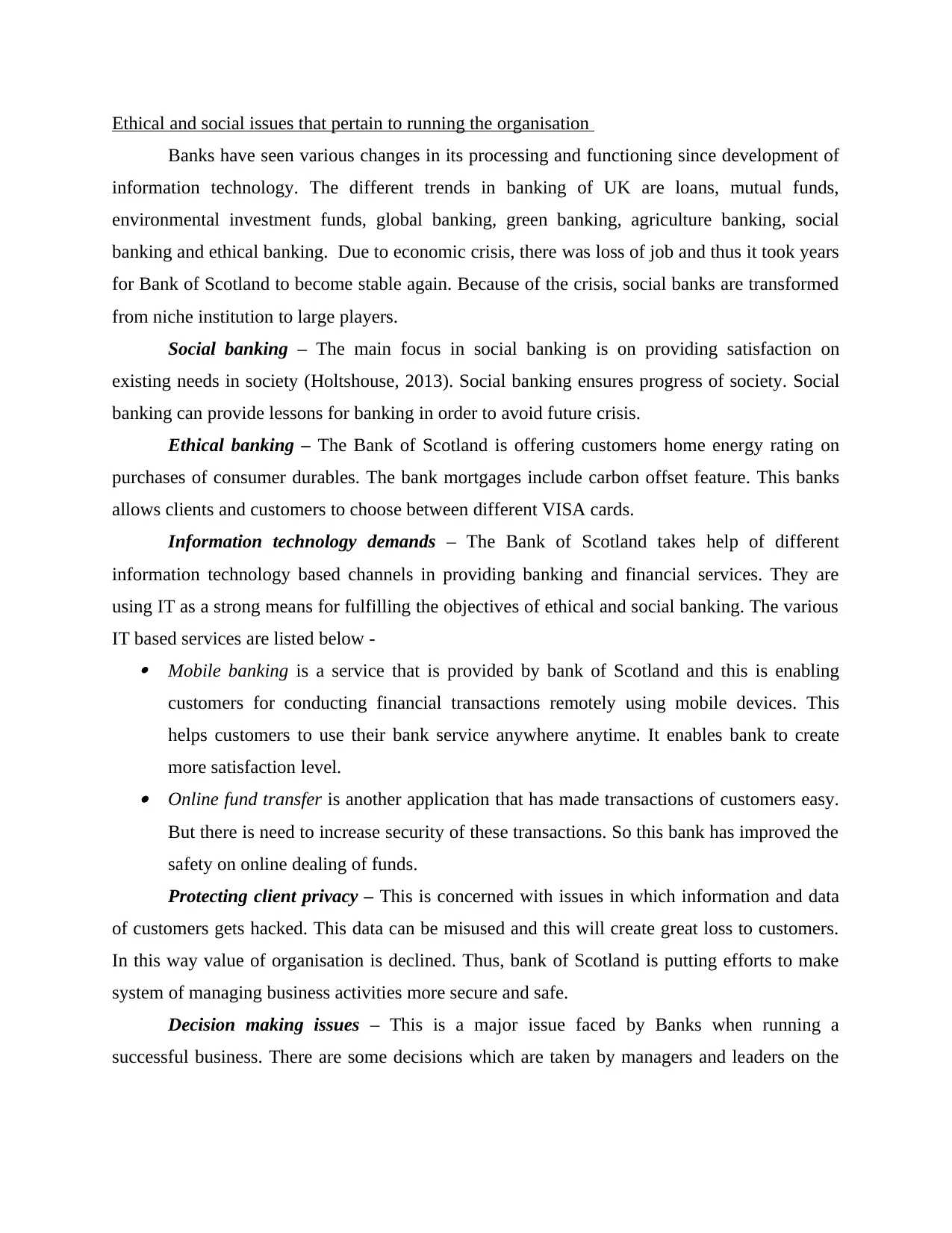
Ethical and social issues that pertain to running the organisation
Banks have seen various changes in its processing and functioning since development of
information technology. The different trends in banking of UK are loans, mutual funds,
environmental investment funds, global banking, green banking, agriculture banking, social
banking and ethical banking. Due to economic crisis, there was loss of job and thus it took years
for Bank of Scotland to become stable again. Because of the crisis, social banks are transformed
from niche institution to large players.
Social banking – The main focus in social banking is on providing satisfaction on
existing needs in society (Holtshouse, 2013). Social banking ensures progress of society. Social
banking can provide lessons for banking in order to avoid future crisis.
Ethical banking – The Bank of Scotland is offering customers home energy rating on
purchases of consumer durables. The bank mortgages include carbon offset feature. This banks
allows clients and customers to choose between different VISA cards.
Information technology demands – The Bank of Scotland takes help of different
information technology based channels in providing banking and financial services. They are
using IT as a strong means for fulfilling the objectives of ethical and social banking. The various
IT based services are listed below - Mobile banking is a service that is provided by bank of Scotland and this is enabling
customers for conducting financial transactions remotely using mobile devices. This
helps customers to use their bank service anywhere anytime. It enables bank to create
more satisfaction level. Online fund transfer is another application that has made transactions of customers easy.
But there is need to increase security of these transactions. So this bank has improved the
safety on online dealing of funds.
Protecting client privacy – This is concerned with issues in which information and data
of customers gets hacked. This data can be misused and this will create great loss to customers.
In this way value of organisation is declined. Thus, bank of Scotland is putting efforts to make
system of managing business activities more secure and safe.
Decision making issues – This is a major issue faced by Banks when running a
successful business. There are some decisions which are taken by managers and leaders on the
Banks have seen various changes in its processing and functioning since development of
information technology. The different trends in banking of UK are loans, mutual funds,
environmental investment funds, global banking, green banking, agriculture banking, social
banking and ethical banking. Due to economic crisis, there was loss of job and thus it took years
for Bank of Scotland to become stable again. Because of the crisis, social banks are transformed
from niche institution to large players.
Social banking – The main focus in social banking is on providing satisfaction on
existing needs in society (Holtshouse, 2013). Social banking ensures progress of society. Social
banking can provide lessons for banking in order to avoid future crisis.
Ethical banking – The Bank of Scotland is offering customers home energy rating on
purchases of consumer durables. The bank mortgages include carbon offset feature. This banks
allows clients and customers to choose between different VISA cards.
Information technology demands – The Bank of Scotland takes help of different
information technology based channels in providing banking and financial services. They are
using IT as a strong means for fulfilling the objectives of ethical and social banking. The various
IT based services are listed below - Mobile banking is a service that is provided by bank of Scotland and this is enabling
customers for conducting financial transactions remotely using mobile devices. This
helps customers to use their bank service anywhere anytime. It enables bank to create
more satisfaction level. Online fund transfer is another application that has made transactions of customers easy.
But there is need to increase security of these transactions. So this bank has improved the
safety on online dealing of funds.
Protecting client privacy – This is concerned with issues in which information and data
of customers gets hacked. This data can be misused and this will create great loss to customers.
In this way value of organisation is declined. Thus, bank of Scotland is putting efforts to make
system of managing business activities more secure and safe.
Decision making issues – This is a major issue faced by Banks when running a
successful business. There are some decisions which are taken by managers and leaders on the
⊘ This is a preview!⊘
Do you want full access?
Subscribe today to unlock all pages.

Trusted by 1+ million students worldwide
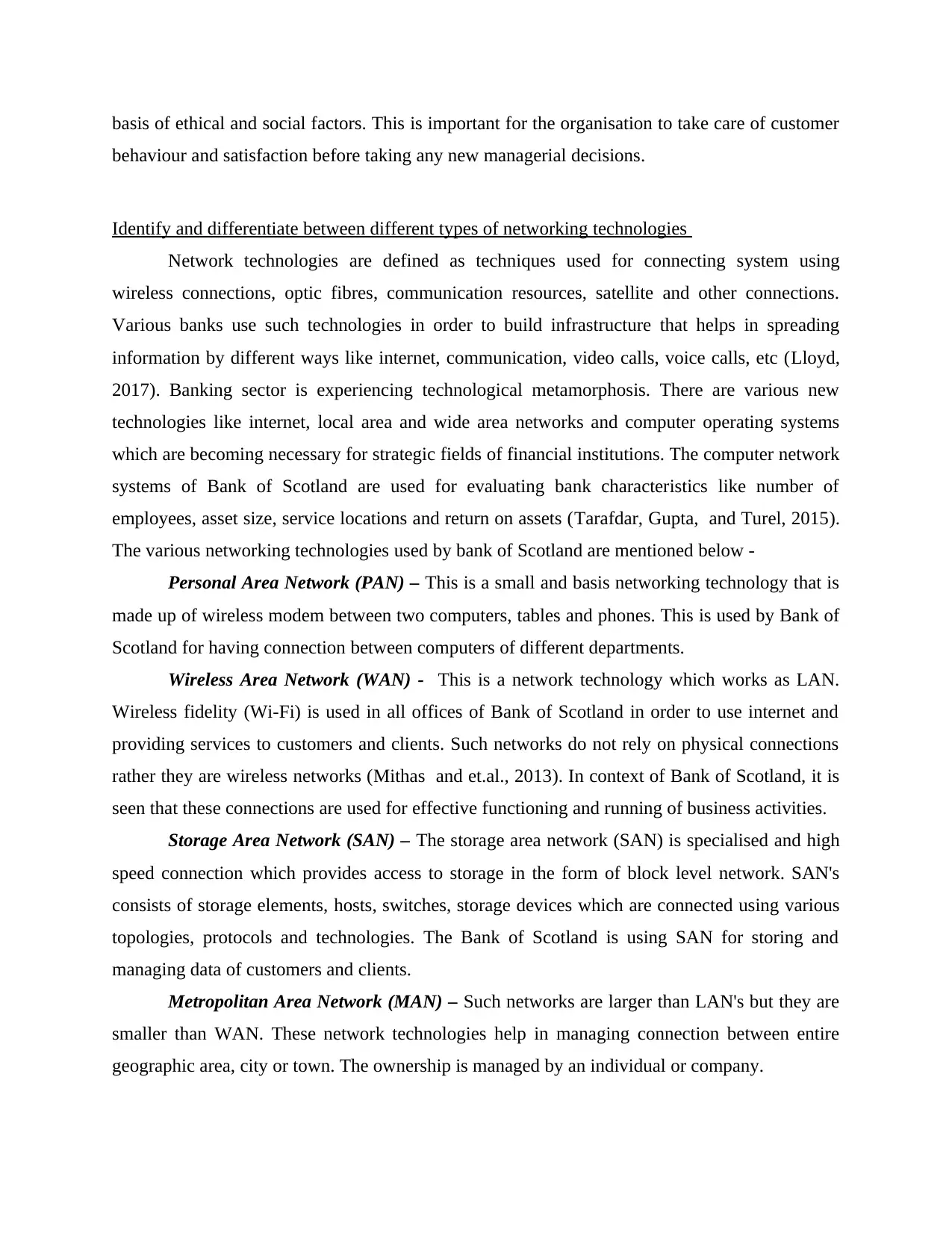
basis of ethical and social factors. This is important for the organisation to take care of customer
behaviour and satisfaction before taking any new managerial decisions.
Identify and differentiate between different types of networking technologies
Network technologies are defined as techniques used for connecting system using
wireless connections, optic fibres, communication resources, satellite and other connections.
Various banks use such technologies in order to build infrastructure that helps in spreading
information by different ways like internet, communication, video calls, voice calls, etc (Lloyd,
2017). Banking sector is experiencing technological metamorphosis. There are various new
technologies like internet, local area and wide area networks and computer operating systems
which are becoming necessary for strategic fields of financial institutions. The computer network
systems of Bank of Scotland are used for evaluating bank characteristics like number of
employees, asset size, service locations and return on assets (Tarafdar, Gupta, and Turel, 2015).
The various networking technologies used by bank of Scotland are mentioned below -
Personal Area Network (PAN) – This is a small and basis networking technology that is
made up of wireless modem between two computers, tables and phones. This is used by Bank of
Scotland for having connection between computers of different departments.
Wireless Area Network (WAN) - This is a network technology which works as LAN.
Wireless fidelity (Wi-Fi) is used in all offices of Bank of Scotland in order to use internet and
providing services to customers and clients. Such networks do not rely on physical connections
rather they are wireless networks (Mithas and et.al., 2013). In context of Bank of Scotland, it is
seen that these connections are used for effective functioning and running of business activities.
Storage Area Network (SAN) – The storage area network (SAN) is specialised and high
speed connection which provides access to storage in the form of block level network. SAN's
consists of storage elements, hosts, switches, storage devices which are connected using various
topologies, protocols and technologies. The Bank of Scotland is using SAN for storing and
managing data of customers and clients.
Metropolitan Area Network (MAN) – Such networks are larger than LAN's but they are
smaller than WAN. These network technologies help in managing connection between entire
geographic area, city or town. The ownership is managed by an individual or company.
behaviour and satisfaction before taking any new managerial decisions.
Identify and differentiate between different types of networking technologies
Network technologies are defined as techniques used for connecting system using
wireless connections, optic fibres, communication resources, satellite and other connections.
Various banks use such technologies in order to build infrastructure that helps in spreading
information by different ways like internet, communication, video calls, voice calls, etc (Lloyd,
2017). Banking sector is experiencing technological metamorphosis. There are various new
technologies like internet, local area and wide area networks and computer operating systems
which are becoming necessary for strategic fields of financial institutions. The computer network
systems of Bank of Scotland are used for evaluating bank characteristics like number of
employees, asset size, service locations and return on assets (Tarafdar, Gupta, and Turel, 2015).
The various networking technologies used by bank of Scotland are mentioned below -
Personal Area Network (PAN) – This is a small and basis networking technology that is
made up of wireless modem between two computers, tables and phones. This is used by Bank of
Scotland for having connection between computers of different departments.
Wireless Area Network (WAN) - This is a network technology which works as LAN.
Wireless fidelity (Wi-Fi) is used in all offices of Bank of Scotland in order to use internet and
providing services to customers and clients. Such networks do not rely on physical connections
rather they are wireless networks (Mithas and et.al., 2013). In context of Bank of Scotland, it is
seen that these connections are used for effective functioning and running of business activities.
Storage Area Network (SAN) – The storage area network (SAN) is specialised and high
speed connection which provides access to storage in the form of block level network. SAN's
consists of storage elements, hosts, switches, storage devices which are connected using various
topologies, protocols and technologies. The Bank of Scotland is using SAN for storing and
managing data of customers and clients.
Metropolitan Area Network (MAN) – Such networks are larger than LAN's but they are
smaller than WAN. These network technologies help in managing connection between entire
geographic area, city or town. The ownership is managed by an individual or company.
Paraphrase This Document
Need a fresh take? Get an instant paraphrase of this document with our AI Paraphraser
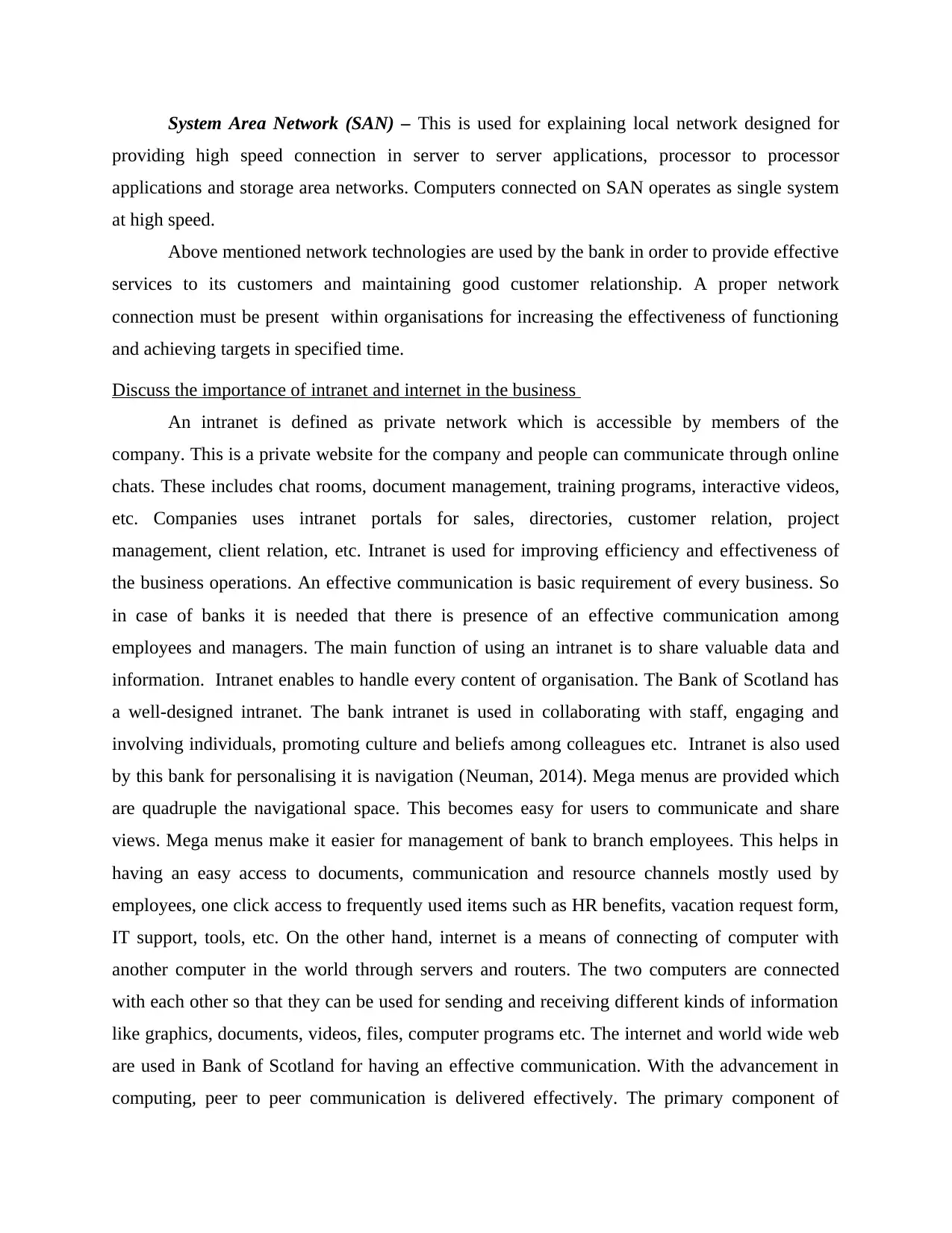
System Area Network (SAN) – This is used for explaining local network designed for
providing high speed connection in server to server applications, processor to processor
applications and storage area networks. Computers connected on SAN operates as single system
at high speed.
Above mentioned network technologies are used by the bank in order to provide effective
services to its customers and maintaining good customer relationship. A proper network
connection must be present within organisations for increasing the effectiveness of functioning
and achieving targets in specified time.
Discuss the importance of intranet and internet in the business
An intranet is defined as private network which is accessible by members of the
company. This is a private website for the company and people can communicate through online
chats. These includes chat rooms, document management, training programs, interactive videos,
etc. Companies uses intranet portals for sales, directories, customer relation, project
management, client relation, etc. Intranet is used for improving efficiency and effectiveness of
the business operations. An effective communication is basic requirement of every business. So
in case of banks it is needed that there is presence of an effective communication among
employees and managers. The main function of using an intranet is to share valuable data and
information. Intranet enables to handle every content of organisation. The Bank of Scotland has
a well-designed intranet. The bank intranet is used in collaborating with staff, engaging and
involving individuals, promoting culture and beliefs among colleagues etc. Intranet is also used
by this bank for personalising it is navigation (Neuman, 2014). Mega menus are provided which
are quadruple the navigational space. This becomes easy for users to communicate and share
views. Mega menus make it easier for management of bank to branch employees. This helps in
having an easy access to documents, communication and resource channels mostly used by
employees, one click access to frequently used items such as HR benefits, vacation request form,
IT support, tools, etc. On the other hand, internet is a means of connecting of computer with
another computer in the world through servers and routers. The two computers are connected
with each other so that they can be used for sending and receiving different kinds of information
like graphics, documents, videos, files, computer programs etc. The internet and world wide web
are used in Bank of Scotland for having an effective communication. With the advancement in
computing, peer to peer communication is delivered effectively. The primary component of
providing high speed connection in server to server applications, processor to processor
applications and storage area networks. Computers connected on SAN operates as single system
at high speed.
Above mentioned network technologies are used by the bank in order to provide effective
services to its customers and maintaining good customer relationship. A proper network
connection must be present within organisations for increasing the effectiveness of functioning
and achieving targets in specified time.
Discuss the importance of intranet and internet in the business
An intranet is defined as private network which is accessible by members of the
company. This is a private website for the company and people can communicate through online
chats. These includes chat rooms, document management, training programs, interactive videos,
etc. Companies uses intranet portals for sales, directories, customer relation, project
management, client relation, etc. Intranet is used for improving efficiency and effectiveness of
the business operations. An effective communication is basic requirement of every business. So
in case of banks it is needed that there is presence of an effective communication among
employees and managers. The main function of using an intranet is to share valuable data and
information. Intranet enables to handle every content of organisation. The Bank of Scotland has
a well-designed intranet. The bank intranet is used in collaborating with staff, engaging and
involving individuals, promoting culture and beliefs among colleagues etc. Intranet is also used
by this bank for personalising it is navigation (Neuman, 2014). Mega menus are provided which
are quadruple the navigational space. This becomes easy for users to communicate and share
views. Mega menus make it easier for management of bank to branch employees. This helps in
having an easy access to documents, communication and resource channels mostly used by
employees, one click access to frequently used items such as HR benefits, vacation request form,
IT support, tools, etc. On the other hand, internet is a means of connecting of computer with
another computer in the world through servers and routers. The two computers are connected
with each other so that they can be used for sending and receiving different kinds of information
like graphics, documents, videos, files, computer programs etc. The internet and world wide web
are used in Bank of Scotland for having an effective communication. With the advancement in
computing, peer to peer communication is delivered effectively. The primary component of
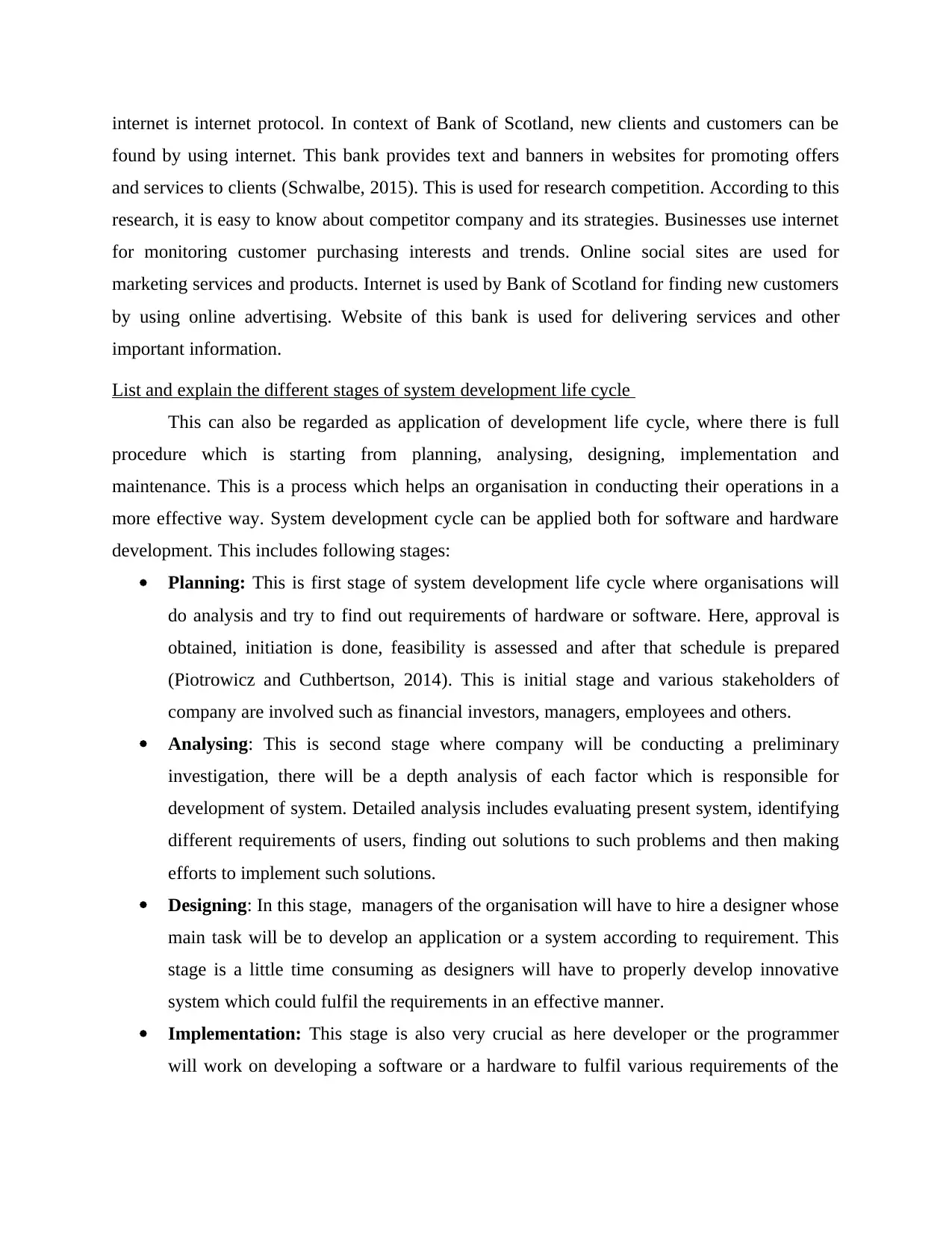
internet is internet protocol. In context of Bank of Scotland, new clients and customers can be
found by using internet. This bank provides text and banners in websites for promoting offers
and services to clients (Schwalbe, 2015). This is used for research competition. According to this
research, it is easy to know about competitor company and its strategies. Businesses use internet
for monitoring customer purchasing interests and trends. Online social sites are used for
marketing services and products. Internet is used by Bank of Scotland for finding new customers
by using online advertising. Website of this bank is used for delivering services and other
important information.
List and explain the different stages of system development life cycle
This can also be regarded as application of development life cycle, where there is full
procedure which is starting from planning, analysing, designing, implementation and
maintenance. This is a process which helps an organisation in conducting their operations in a
more effective way. System development cycle can be applied both for software and hardware
development. This includes following stages:
Planning: This is first stage of system development life cycle where organisations will
do analysis and try to find out requirements of hardware or software. Here, approval is
obtained, initiation is done, feasibility is assessed and after that schedule is prepared
(Piotrowicz and Cuthbertson, 2014). This is initial stage and various stakeholders of
company are involved such as financial investors, managers, employees and others.
Analysing: This is second stage where company will be conducting a preliminary
investigation, there will be a depth analysis of each factor which is responsible for
development of system. Detailed analysis includes evaluating present system, identifying
different requirements of users, finding out solutions to such problems and then making
efforts to implement such solutions.
Designing: In this stage, managers of the organisation will have to hire a designer whose
main task will be to develop an application or a system according to requirement. This
stage is a little time consuming as designers will have to properly develop innovative
system which could fulfil the requirements in an effective manner.
Implementation: This stage is also very crucial as here developer or the programmer
will work on developing a software or a hardware to fulfil various requirements of the
found by using internet. This bank provides text and banners in websites for promoting offers
and services to clients (Schwalbe, 2015). This is used for research competition. According to this
research, it is easy to know about competitor company and its strategies. Businesses use internet
for monitoring customer purchasing interests and trends. Online social sites are used for
marketing services and products. Internet is used by Bank of Scotland for finding new customers
by using online advertising. Website of this bank is used for delivering services and other
important information.
List and explain the different stages of system development life cycle
This can also be regarded as application of development life cycle, where there is full
procedure which is starting from planning, analysing, designing, implementation and
maintenance. This is a process which helps an organisation in conducting their operations in a
more effective way. System development cycle can be applied both for software and hardware
development. This includes following stages:
Planning: This is first stage of system development life cycle where organisations will
do analysis and try to find out requirements of hardware or software. Here, approval is
obtained, initiation is done, feasibility is assessed and after that schedule is prepared
(Piotrowicz and Cuthbertson, 2014). This is initial stage and various stakeholders of
company are involved such as financial investors, managers, employees and others.
Analysing: This is second stage where company will be conducting a preliminary
investigation, there will be a depth analysis of each factor which is responsible for
development of system. Detailed analysis includes evaluating present system, identifying
different requirements of users, finding out solutions to such problems and then making
efforts to implement such solutions.
Designing: In this stage, managers of the organisation will have to hire a designer whose
main task will be to develop an application or a system according to requirement. This
stage is a little time consuming as designers will have to properly develop innovative
system which could fulfil the requirements in an effective manner.
Implementation: This stage is also very crucial as here developer or the programmer
will work on developing a software or a hardware to fulfil various requirements of the
⊘ This is a preview!⊘
Do you want full access?
Subscribe today to unlock all pages.

Trusted by 1+ million students worldwide
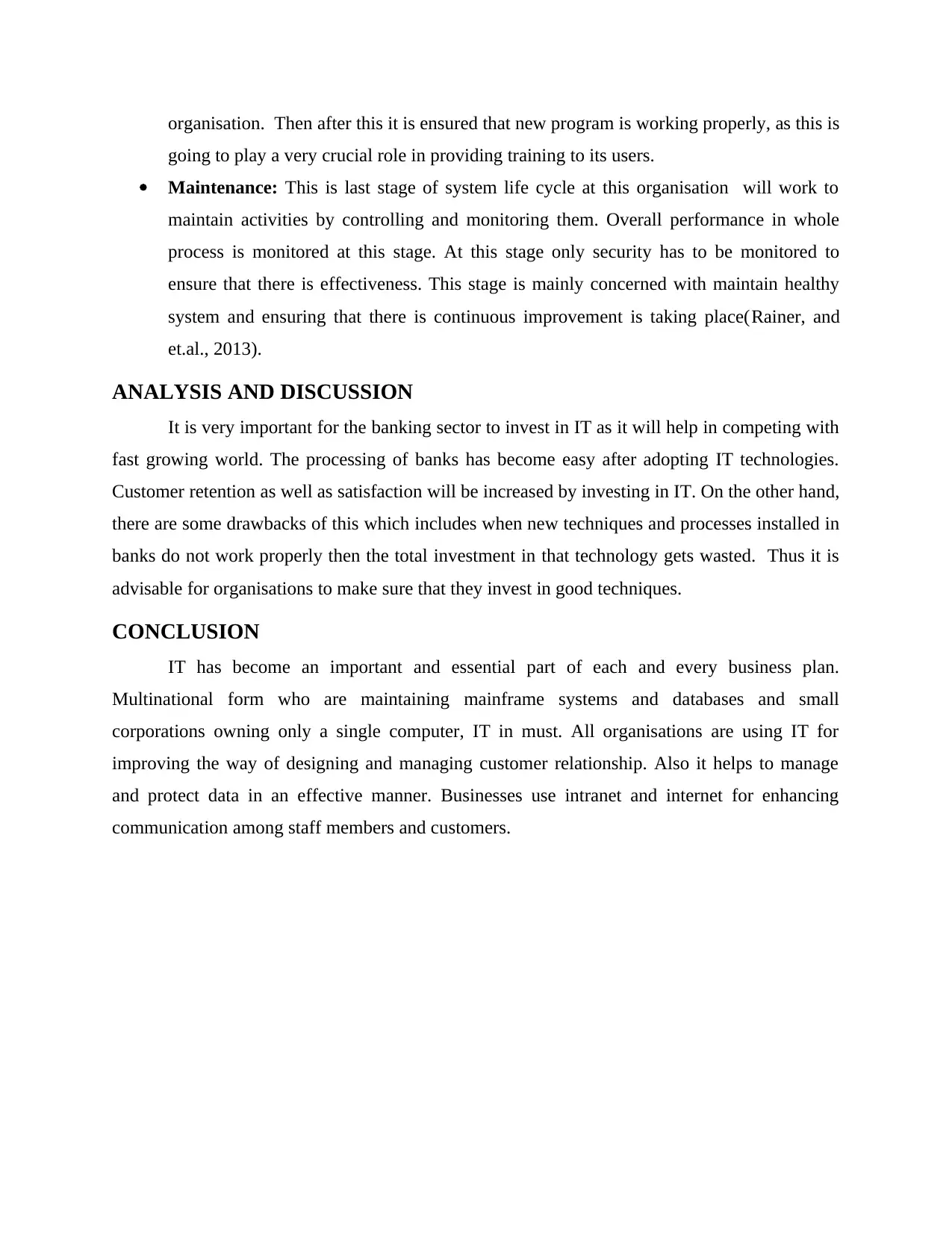
organisation. Then after this it is ensured that new program is working properly, as this is
going to play a very crucial role in providing training to its users.
Maintenance: This is last stage of system life cycle at this organisation will work to
maintain activities by controlling and monitoring them. Overall performance in whole
process is monitored at this stage. At this stage only security has to be monitored to
ensure that there is effectiveness. This stage is mainly concerned with maintain healthy
system and ensuring that there is continuous improvement is taking place(Rainer, and
et.al., 2013).
ANALYSIS AND DISCUSSION
It is very important for the banking sector to invest in IT as it will help in competing with
fast growing world. The processing of banks has become easy after adopting IT technologies.
Customer retention as well as satisfaction will be increased by investing in IT. On the other hand,
there are some drawbacks of this which includes when new techniques and processes installed in
banks do not work properly then the total investment in that technology gets wasted. Thus it is
advisable for organisations to make sure that they invest in good techniques.
CONCLUSION
IT has become an important and essential part of each and every business plan.
Multinational form who are maintaining mainframe systems and databases and small
corporations owning only a single computer, IT in must. All organisations are using IT for
improving the way of designing and managing customer relationship. Also it helps to manage
and protect data in an effective manner. Businesses use intranet and internet for enhancing
communication among staff members and customers.
going to play a very crucial role in providing training to its users.
Maintenance: This is last stage of system life cycle at this organisation will work to
maintain activities by controlling and monitoring them. Overall performance in whole
process is monitored at this stage. At this stage only security has to be monitored to
ensure that there is effectiveness. This stage is mainly concerned with maintain healthy
system and ensuring that there is continuous improvement is taking place(Rainer, and
et.al., 2013).
ANALYSIS AND DISCUSSION
It is very important for the banking sector to invest in IT as it will help in competing with
fast growing world. The processing of banks has become easy after adopting IT technologies.
Customer retention as well as satisfaction will be increased by investing in IT. On the other hand,
there are some drawbacks of this which includes when new techniques and processes installed in
banks do not work properly then the total investment in that technology gets wasted. Thus it is
advisable for organisations to make sure that they invest in good techniques.
CONCLUSION
IT has become an important and essential part of each and every business plan.
Multinational form who are maintaining mainframe systems and databases and small
corporations owning only a single computer, IT in must. All organisations are using IT for
improving the way of designing and managing customer relationship. Also it helps to manage
and protect data in an effective manner. Businesses use intranet and internet for enhancing
communication among staff members and customers.
Paraphrase This Document
Need a fresh take? Get an instant paraphrase of this document with our AI Paraphraser
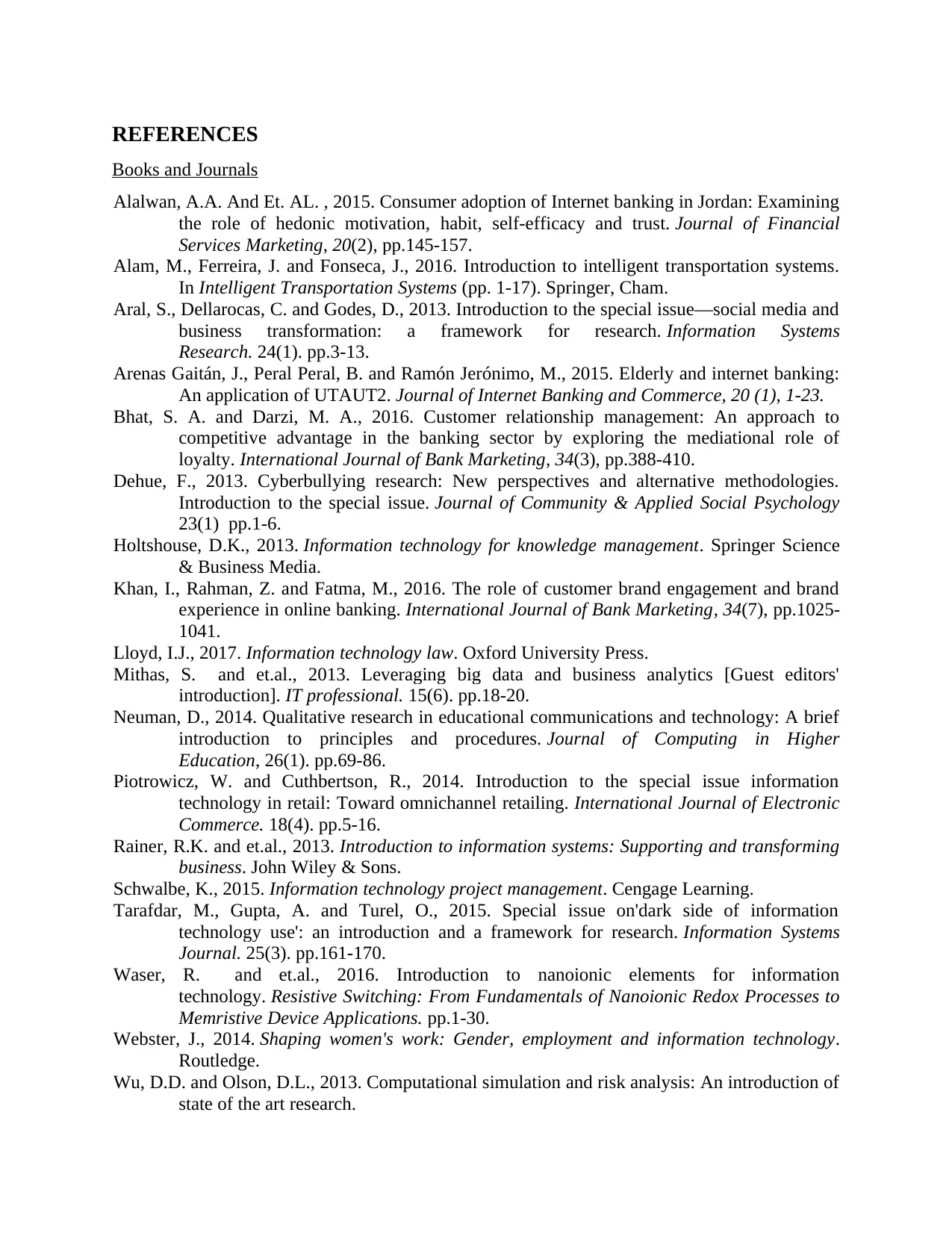
REFERENCES
Books and Journals
Alalwan, A.A. And Et. AL. , 2015. Consumer adoption of Internet banking in Jordan: Examining
the role of hedonic motivation, habit, self-efficacy and trust. Journal of Financial
Services Marketing, 20(2), pp.145-157.
Alam, M., Ferreira, J. and Fonseca, J., 2016. Introduction to intelligent transportation systems.
In Intelligent Transportation Systems (pp. 1-17). Springer, Cham.
Aral, S., Dellarocas, C. and Godes, D., 2013. Introduction to the special issue—social media and
business transformation: a framework for research. Information Systems
Research. 24(1). pp.3-13.
Arenas Gaitán, J., Peral Peral, B. and Ramón Jerónimo, M., 2015. Elderly and internet banking:
An application of UTAUT2. Journal of Internet Banking and Commerce, 20 (1), 1-23.
Bhat, S. A. and Darzi, M. A., 2016. Customer relationship management: An approach to
competitive advantage in the banking sector by exploring the mediational role of
loyalty. International Journal of Bank Marketing, 34(3), pp.388-410.
Dehue, F., 2013. Cyberbullying research: New perspectives and alternative methodologies.
Introduction to the special issue. Journal of Community & Applied Social Psychology
23(1) pp.1-6.
Holtshouse, D.K., 2013. Information technology for knowledge management. Springer Science
& Business Media.
Khan, I., Rahman, Z. and Fatma, M., 2016. The role of customer brand engagement and brand
experience in online banking. International Journal of Bank Marketing, 34(7), pp.1025-
1041.
Lloyd, I.J., 2017. Information technology law. Oxford University Press.
Mithas, S. and et.al., 2013. Leveraging big data and business analytics [Guest editors'
introduction]. IT professional. 15(6). pp.18-20.
Neuman, D., 2014. Qualitative research in educational communications and technology: A brief
introduction to principles and procedures. Journal of Computing in Higher
Education, 26(1). pp.69-86.
Piotrowicz, W. and Cuthbertson, R., 2014. Introduction to the special issue information
technology in retail: Toward omnichannel retailing. International Journal of Electronic
Commerce. 18(4). pp.5-16.
Rainer, R.K. and et.al., 2013. Introduction to information systems: Supporting and transforming
business. John Wiley & Sons.
Schwalbe, K., 2015. Information technology project management. Cengage Learning.
Tarafdar, M., Gupta, A. and Turel, O., 2015. Special issue on'dark side of information
technology use': an introduction and a framework for research. Information Systems
Journal. 25(3). pp.161-170.
Waser, R. and et.al., 2016. Introduction to nanoionic elements for information
technology. Resistive Switching: From Fundamentals of Nanoionic Redox Processes to
Memristive Device Applications. pp.1-30.
Webster, J., 2014. Shaping women's work: Gender, employment and information technology.
Routledge.
Wu, D.D. and Olson, D.L., 2013. Computational simulation and risk analysis: An introduction of
state of the art research.
Books and Journals
Alalwan, A.A. And Et. AL. , 2015. Consumer adoption of Internet banking in Jordan: Examining
the role of hedonic motivation, habit, self-efficacy and trust. Journal of Financial
Services Marketing, 20(2), pp.145-157.
Alam, M., Ferreira, J. and Fonseca, J., 2016. Introduction to intelligent transportation systems.
In Intelligent Transportation Systems (pp. 1-17). Springer, Cham.
Aral, S., Dellarocas, C. and Godes, D., 2013. Introduction to the special issue—social media and
business transformation: a framework for research. Information Systems
Research. 24(1). pp.3-13.
Arenas Gaitán, J., Peral Peral, B. and Ramón Jerónimo, M., 2015. Elderly and internet banking:
An application of UTAUT2. Journal of Internet Banking and Commerce, 20 (1), 1-23.
Bhat, S. A. and Darzi, M. A., 2016. Customer relationship management: An approach to
competitive advantage in the banking sector by exploring the mediational role of
loyalty. International Journal of Bank Marketing, 34(3), pp.388-410.
Dehue, F., 2013. Cyberbullying research: New perspectives and alternative methodologies.
Introduction to the special issue. Journal of Community & Applied Social Psychology
23(1) pp.1-6.
Holtshouse, D.K., 2013. Information technology for knowledge management. Springer Science
& Business Media.
Khan, I., Rahman, Z. and Fatma, M., 2016. The role of customer brand engagement and brand
experience in online banking. International Journal of Bank Marketing, 34(7), pp.1025-
1041.
Lloyd, I.J., 2017. Information technology law. Oxford University Press.
Mithas, S. and et.al., 2013. Leveraging big data and business analytics [Guest editors'
introduction]. IT professional. 15(6). pp.18-20.
Neuman, D., 2014. Qualitative research in educational communications and technology: A brief
introduction to principles and procedures. Journal of Computing in Higher
Education, 26(1). pp.69-86.
Piotrowicz, W. and Cuthbertson, R., 2014. Introduction to the special issue information
technology in retail: Toward omnichannel retailing. International Journal of Electronic
Commerce. 18(4). pp.5-16.
Rainer, R.K. and et.al., 2013. Introduction to information systems: Supporting and transforming
business. John Wiley & Sons.
Schwalbe, K., 2015. Information technology project management. Cengage Learning.
Tarafdar, M., Gupta, A. and Turel, O., 2015. Special issue on'dark side of information
technology use': an introduction and a framework for research. Information Systems
Journal. 25(3). pp.161-170.
Waser, R. and et.al., 2016. Introduction to nanoionic elements for information
technology. Resistive Switching: From Fundamentals of Nanoionic Redox Processes to
Memristive Device Applications. pp.1-30.
Webster, J., 2014. Shaping women's work: Gender, employment and information technology.
Routledge.
Wu, D.D. and Olson, D.L., 2013. Computational simulation and risk analysis: An introduction of
state of the art research.
1 out of 11
Related Documents
Your All-in-One AI-Powered Toolkit for Academic Success.
+13062052269
info@desklib.com
Available 24*7 on WhatsApp / Email
![[object Object]](/_next/static/media/star-bottom.7253800d.svg)
Unlock your academic potential
Copyright © 2020–2025 A2Z Services. All Rights Reserved. Developed and managed by ZUCOL.





